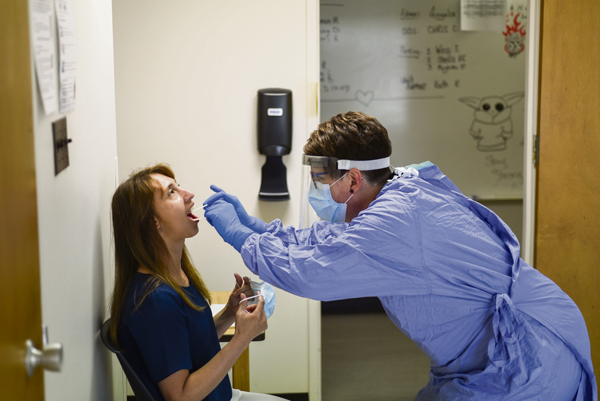The Saskatchewan Health Authority (SHA) is hoping to decrease the stigma surrounding COVID-19 testing.
To do this, media had the opportunity to ask a number of panelists—ranging from employees who perform the tests, have had it done on themselves or work in a laboratory—about what the testing process is like.
Tracy Sanden has been working at a COVID-19 testing site. Sanden said a lot of patients have expressed worry about the process, and she hopes that speaking out will ease their concerns.
She said people have feared that they will contract the virus at the testing site.
“I think a lot of people think about a doctor’s waiting room where people are going to get coughed on, and the risk of contracting COVID-19 at a testing site is really low,” she said.
Sanden, as well as Regina test site lead Chris Cave, said the SHA is diligent in the use of personal protective equipment. Patients are given a mask upon arrival to the testing site and must stay in their vehicles until someone escorts them inside.
Another thing people worry about, said Sanden, is being seen or identified. If you live in a small community, for example, Sanden said you can travel to another community to get tested. Additionally, you can share your concerns with HealthLine 811 or your health care provider and they may be able to offer an alternative.
Sanden herself has also been tested for the virus not only for the results, “but to also go through the process and have that first-hand experience to be able to share and strengthen that relationship with the people I’ve been talking to.”
The swabbing process doesn’t hurt, she said, but it is a little bit uncomfortable.
“You can feel it, but I wouldn’t ever say it was painful. My eyes watered a little bit, but they graciously passed the Kleenex over. I could bat my eyes, and it was a really quick process.”
Monica Reinkens, a patient family advisor, also sought testing. She agreed that it’s uncomfortable, but lasts mere seconds.
Cave said there are two types of swabs.
The nasopharyngeal swab is typically used for children and people requiring specialized treatment. The swab is long, flexible and has a soft tip.
Patients must tilt their head back 70 degrees. The swab is inserted into their nose and held there for about five seconds.
The second type is known as the throat and nostril swab, where the employee will first push your tongue down with a depressor. Then, they’ll touch the swab to the back of your throat, and then the same swab is used for both nostrils.
This one is the most common and is typically used for adults because children typically won’t let the employee do the nostril swabs after the throat.
Dr. Jessica Minion, acting provincial clinical lead for public health in laboratory medicine, said each employee is trained to do the procedure correctly.
“The specimen collection is really important to get an accurate result,” she said.
The SHA said while physical distancing and hand washing are important to prevent the spread of COVID-19, testing is also an essential component.
Chantel LaHaye, director of primary health in Regina, said nobody is discouraged from seeking testing. However, in order to ensure an accurate result, they ask that anyone who is symptomatic wait 48 hours prior to testing.
The SHA strongly recommends testing for people experiencing symptoms such as fever, headaches, cough, dizziness, fatigue, aches and cramps, chills and difficulty breathing.
Testing is available for people who are asymptomatic, though.
This includes anyone working from outside of their homes or returning to work as part of the Re-Open Saskatchewan Plan. It also includes those who are immunocompromised, patients being admitted to an acute care hospital for at least a 24-hour stay and for people who are homeless or living in other vulnerable settings.


